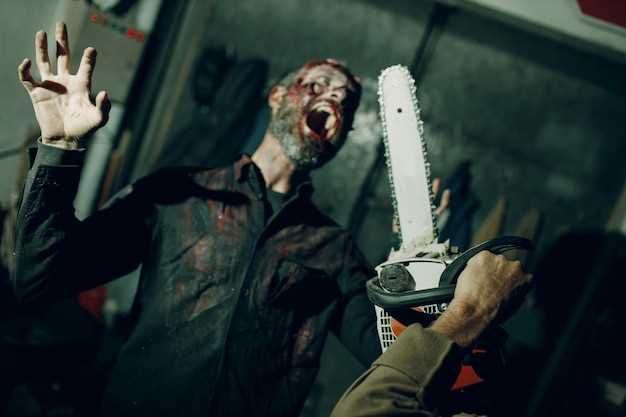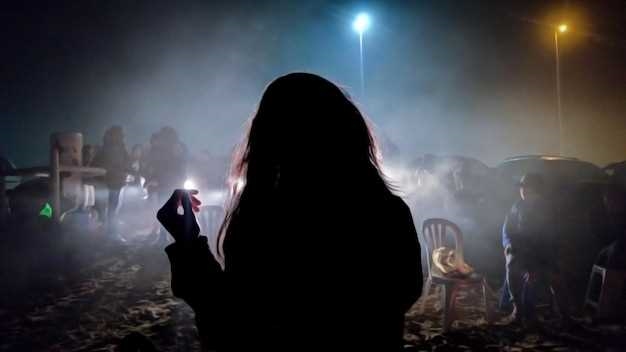
Within the bewitching realm of frightful enigmas and dark curiosities lies an art form that has the power to transform our deepest fears into tangible reality. Step behind the mesmerizing masterpiece that enthralls our senses with spine-tingling terror and immerse yourself in the captivating universe of crafting hair-raising special effects in bone-chilling films.
Unleashing the macabre genius of imaginative minds and technical prowess, this domain weaves a mesmerizing tapestry of dread that leaves audiences quivering in both awe and terror. With a combination of astonishing skill and innovative techniques, creators conjure up a world beyond rational comprehension, where nightmarish phantoms and grotesque monstrosities dance under flickering lights.
Imbued with a seamless blend of artistry and technological ingenuity, this extraordinary craft requires not only a deep understanding of the human psyche, but also an unwavering commitment to pushing the boundaries of possibility. Each scene, meticulously orchestrated and executed, immerses viewers in gripping suspensions of reality, where the distinction between the tangible and the ethereal becomes perilously blurred.
Unveiling the Secrets of Terrifying Special Effects in Horror Films
Step into the dark and mysterious world of horror films, where unimaginable nightmares come to life. In this mesmerizing journey, we will delve into the hidden realm of special effects that captivate and terrify viewers. Prepare yourself for a spine-chilling exploration of the techniques and craftsmanship that bring these horrifying visions to the screen.
Tapping into the Darkest Depths of Creativity
Behind the veil of fright and suspense lies a realm where artistic ingenuity takes center stage. The creative geniuses responsible for designing the terrifying special effects in horror films possess a deep understanding of fear and its psychological impact. Armed with this knowledge, they push the boundaries of imagination and challenge the senses in ways that leave audiences trembling with terror.
The Craftsmanship that Conjures Fear
Every haunting detail in a horror film’s special effects is meticulously crafted to invoke a visceral reaction. From the eerie prosthetics that transform actors into grotesque creatures to the blood-curdling sounds that make hearts race, each element is carefully considered and tastefully combined to provoke a potent emotional response. The artistry of the makeup artists, sound designers, and visual effects teams is unparalleled, as they work together seamlessly to create a symphony of fear that lingers in our nightmares.
Unveiling the secrets of terrifying special effects in horror films reveals a world where the boundaries of reality are shattered and the darkest recesses of the human mind are exposed. Prepare to be immersed in a chilling tale of creativity and craftsmanship, as the macabre beauty of horror comes alive before your eyes.
The Art of Creating Realistic Gore and Bloodshed
In the world of horror cinema, one of the most important aspects in delivering a truly bone-chilling experience is the portrayal of realistic gore and bloodshed. While these elements may be unsettling to some, they play a crucial role in creating the desired impact and immersing the audience in the terrifying world of the film.
Ensuring Authenticity: From Prosthetics to Practical Effects
When it comes to creating realistic gore and bloodshed, filmmakers rely on a combination of prosthetic makeup, practical effects, and intricate attention to detail. Prosthetic limbs, fake blood, and special effects makeup are meticulously designed and crafted to resemble human flesh, bones, and bodily fluids.
A team of skilled makeup artists work tirelessly to create wounds and injuries that are shockingly realistic. They meticulously apply fake blood and flesh-like materials to actors’ bodies and create the illusion of mutilation, lacerations, and other gruesome injuries.
The Art of Spilling Blood: Techniques and Tricks
Creating convincing bloodshed requires careful planning and the use of various techniques and tricks. Filmmakers employ a range of methods to achieve the desired effect, including the use of practical blood packs, squibs, and digital enhancements.
Practical blood packs are strategically hidden on actors’ bodies, allowing them to release blood at the right moment. These packs can be triggered manually or remotely, creating the illusion of fresh wounds and spurting blood. Squibs, on the other hand, are small explosive devices that simulate the impact of a gunshot or similar trauma, resulting in realistic blood splatter.
In some instances, digital enhancements are used to enhance the realism of bloodshed. Special effects artists employ computer-generated imagery (CGI) to add or enhance the blood effects, ensuring that the final result is truly spine-chilling.
| Techniques | Tools |
|---|---|
| Squibs | Explosive Devices |
| Blood Packs | Hidden Pouches |
| CGI enhancements | Computer-generated Imagery |
By skillfully combining these techniques and tools, horror filmmakers are able to create the illusion of realistic gore and bloodshed, leaving audiences cringing in their seats and providing an unforgettable cinematic experience.
Mastering the Craft of Monster Makeup and Prosthetics
Achieving the artistry of bringing terrifying creatures to life in horror films requires a deep understanding and skillful mastery of monster makeup and prosthetics. This integral aspect of filmmaking involves the creation and application of realistic and spine-chilling effects that evoke fear and captivate audiences. In this section, we delve into the meticulous process and techniques involved in perfecting the craft of monster makeup and prosthetics.
| Section | Description |
|---|---|
| Conceptualization | The first step in crafting monster makeup and prosthetics involves conceptualizing the terrifying creature. From sketching initial designs to creating detailed sculptures, artists hone their imagination and bring it to life through visual representation. |
| Materials and Tools | Utilizing a vast array of specialized materials and tools, makeup artists and prosthetic experts employ their expertise to select the ideal components that will seamlessly blend with an actor’s natural features. Techniques such as casting, mold making, and silicone application play a pivotal role in achieving a realistic effect. |
| Application Process | All the meticulous planning and preparation culminate in the delicate process of applying monster makeup and prosthetics. With skilled hands and attention to detail, artists transform actors into horrifying creatures, employing techniques like airbrushing, prosthetic attachment, and intricately hand-painting details. |
| Testing and Adjustment | After the initial application, tests and adjustments are crucial to ensure the makeup and prosthetics achieve the desired effect under various lighting conditions and camera angles. Artists collaborate with filmmakers to make necessary refinements, guaranteeing that the monster’s appearance translates effectively on the screen. |
| Collaboration and Execution | The successful execution of monster makeup and prosthetics heavily relies on effective collaboration between makeup artists, prosthetic specialists, costume designers, and the director. By seamlessly integrating their expertise, they create a cohesive and bone-chilling vision that haunts viewers long after the film’s end. |
In conclusion, the craft of monster makeup and prosthetics in horror films requires not only technical skills but also a vivid imagination and attention to detail. Through a meticulous and collaborative process, artists bring terrifying creatures to life, enhancing the thrilling experience of horror cinema for audiences around the world.
Delving into the World of Animatronics and Creature Creation
Exploring the captivating realm of animatronics and creature creation unveils the intricate marvels hidden beneath the surface of horror films. This enthralling domain, characterized by its mastery in bringing lifelike creatures to existence, demands a symphony of artistic craftsmanship and technological brilliance. Delve into the mesmerizing world where imagination meets engineering, as we embark on a journey to unravel the secrets behind these terrifyingly realistic beings.
Revolutionizing Realism Through Animatronics
The magic of animatronics lies in its ability to blur the line between reality and the fantastical, captivating audiences with its astonishing lifelike movements. These technical marvels harness a combination of robotics, mechanics, and imaginative design to manifest creatures that exist only in the depths of our wildest nightmares.
The Creation Process Unveiled
Embarking on the fascinating process of creature creation offers a glimpse into the meticulously crafted steps that bring these eerie beings to life. The journey typically begins with concept sketches, where the creature’s appearance and personality are brainstormed and refined. From there, sculptors meticulously shape the creature’s physical form, ensuring every detail contributes to its terrifying allure.
- Conceptualizing the Creature’s Persona
- Translating Ideas into Skeletal Frameworks
- Perfecting the Outer Shell: From Clay to Silicone
- The Art of Painting and Texturing
- Breathing Life into the Animatronics: Wiring and Electronics
Special effects artists collaborate with engineers and puppeteers to embed intricate animatronic systems within the creature’s structure, orchestrating movements that breathe life into the character. These systems often involve a combination of air pressure, hydraulics, and electrical mechanisms, precisely synchronized to produce seamless movements that mimic those of living beings.
As the creature creation journey nears completion, meticulous paint and texture artists work their magic, ensuring the final product possesses the skin, scales, or fur required to strike terror into the hearts of viewers. Each stroke is deliberately applied to enhance realism, adding depth and dimension to the creature’s physicality.
The culmination of these ingenious processes gives rise to a creature that transcends the limitations of mere imagination, existing as a tangible nightmare within the realms of the silver screen. The world of animatronics and creature creation represents the marriage of artistic ingenuity and technological prowess, providing horror films with the ability to terrify and captivate audiences for decades to come.
The Magic of Practical Effects: How to Make Objects Move on Their Own
Unlocking the secrets behind the mesmerizing movements of objects in horror films is like unraveling a captivating enigma. In this section, we delve into the fascinating world of practical effects to uncover the techniques used to make inanimate objects come alive and move on their own. No CGI or computer tricks are involved here – it’s all hands-on magic!
Creative Puppetry and Animatronics
One of the key aspects of bringing objects to life is through the art of puppetry and animatronics. Skilled puppeteers manipulate the objects with precision and expertise, carefully controlling their movements to create the illusion of autonomy. Magnets, strings, and even remote-controlled mechanisms are cleverly employed to make objects appear to move on their own accord. The ingenuity and craftsmanship behind these practical effects are what adds an authentic and thrilling touch to horror films.
The Power of Mechanics and Hydraulics
Another technique used to make objects defy gravity and move autonomously is the use of mechanics and hydraulics. Hidden mechanisms can be installed within objects, enabling them to move in unexpected and eerie ways. Springs, levers, and pistons are utilized to power these mechanisms, carefully concealed from the viewer’s eye. By applying principles of physics and engineering, horror filmmakers can create unforgettable moments of astonishment and suspense by making objects appear to possess a life of their own.
Whether it’s a possessed doll creeping across a dimly lit room or a haunted painting shaking violently on a wall, the use of practical effects to make objects move on their own adds an extra layer of realism to horror movies. It allows filmmakers to tap into our primal fears and ignite our imagination, leaving us both terrified and in awe of the movie magic created behind the scenes.
Exploring the Dark Art of Visual Effects in Horror Movies
Delving into the mesmerizing world of visual effects in the realm of horror cinema allows us to uncover the mystifying techniques used to create spine-chilling and hair-raising moments on screen. Here, we embark on a journey to understand the sinister craftsmanship behind the terrifying illusions that leave us trembling in our seats.
1. Unleashing the Power of Practical Effects
One of the key elements in creating a truly terrifying horror movie experience lies in the skillful execution of practical effects. From elaborately crafted prosthetics and gruesome makeup to blood-splattering splatter-gore and convincingly grotesque monsters, practical effects bring a visceral and tangible quality to the scares. This section takes a closer look at the masterful artistry behind these physical creations that make our hearts race and our skin crawl.
2. Harnessing the Dark Magic of CGI
While practical effects possess a certain charm, the advent of CGI has allowed horror filmmakers to push the boundaries of imagination and plunge audiences into nightmarish realms previously unimaginable. This segment explores the eerie world of computer-generated imagery and uncovers the sophisticated techniques used to seamlessly blend the real and the supernatural. From seamlessly integrating lifelike creatures to conjuring surreal environments, CGI has become a powerful tool in intensifying the horror experience.
3. Crafting Haunting Visual Atmosphere
Creating an effectively chilling atmosphere is crucial to the overall impact of a horror film. This section delves into the art of cinematography and lighting techniques employed to cultivate an atmosphere of dread and suspense. From unsettling camera angles and shadowy silhouettes to the strategic use of color and contrast, these visual elements work in harmony to unnerve audiences and immerse them in an unsettling world of fear.
4. Enhancing the Horrors through Sound Design
The power of sound should never be underestimated when it comes to amplifying the scares in horror movies. In this part, we explore the intricacies of sound design, including the composition of spine-tingling musical scores and the creation of spine-chilling sound effects. Discover the secrets behind the unnerving audio landscapes that haunt our nightmares long after the movie ends.
- Unleashing the Power of Practical Effects
- Harnessing the Dark Magic of CGI
- Crafting Haunting Visual Atmosphere
- Enhancing the Horrors through Sound Design
By delving into these mesmerizing aspects of visual effects, we gain a deeper appreciation for the dark artistry that goes beyond the surface of horror movies. Understanding the intricate techniques allows us to marvel at the creativity and talent behind the terrifying spectacles that continue to captivate and haunt audiences worldwide.
From Sound Design to Jump Scares: Crafting the Perfect Horror Atmosphere
Delving into the intricate art of horror filmmaking, this section unveils the secrets behind the construction of an unparalleled spine-chilling ambiance. By combining the mastery of sound design with the precise placement of jump scares, filmmakers strive to create an atmosphere that leaves audiences trembling with fear.
Setting the Stage with Sound Design
Sound design acts as the cornerstone in building the eerie atmosphere that grips viewers right from the start. Carefully selected sounds, whether it be a creaking floorboard or a distant whisper, have the power to induce a sense of foreboding. These auditory elements serve to plant seeds of unease in the minds of the audience, heightening their anticipation for what lurks around the corner. The manipulation of sound waves is a craft in its own right, capable of intensifying emotions and instilling a deep-seated dread that lingers long after the credits roll.
Mastering the Art of Jump Scares
Jump scares, those heart-pounding moments that make even the bravest souls leap out of their seats, are a quintessential aspect of crafting a perfect horror atmosphere. Far from mere cheap shots, their careful execution requires meticulous timing, precise editing, and an in-depth understanding of human psychology. The sudden appearance of a horrifying figure or the unexpected jolt of a sound effect provokes an instinctive fear response, eliciting an adrenaline rush in the audience. The well-crafted jump scare can leave a lasting impression, haunting the dreams of viewers for nights to come.
Striking a Balance for Maximum Impact
To achieve the ultimate horror atmosphere, a delicate balance must be struck between sound design and jump scares. Each element must complement the other, working together harmoniously to escalate tension and evoke a visceral reaction. The strategic placement of jump scares within the carefully crafted soundscape ensures that audiences are kept on their toes, with hearts pounding and nerves on edge. When perfectly aligned, these two components merge to create a sensory experience that immerses viewers in a nightmarish world, where fear reigns supreme.
In conclusion, the creation of a truly chilling horror atmosphere requires a meticulous combination of sound design and well-executed jump scares. By harnessing the power of carefully selected sounds and precisely timed jolts, filmmakers are able to transport audiences into a realm of terror and suspense unlike any other. The artistry woven into the construction of the horror atmosphere is what keeps viewers captivated, long after the lights in the theater have dimmed.

